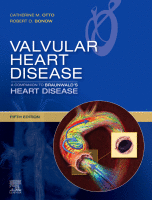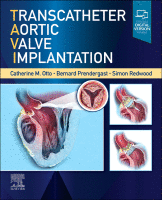Physical Address
304 North Cardinal St.
Dorchester Center, MA 02124

Key points The estimated prevalence of mitral valve prolapse (MVP) for the general population is 2.4%. The term mitral valve prolapse refers to leaflet prolapse resulting from an elongated chorda and/or leaflet. It is usually diagnosed with the use of echocardiography as excessive systolic movement of a leaflet (≥2 mm) beyond the level of the saddle-shaped annulus. Anatomic lesions encompass a wide spectrum of disease, from…

Key points Although the incidence of rheumatic heart diseases has decreased, mitral stenosis (MS) remains prevalent in developed countries. It is common and underdiagnosed in developing countries. Calcific MS is the consequence of extensive mitral annular calcification, the prevalence of which increases markedly with age. Clinical assessment is paramount to detect MS in asymptomatic patients and to evaluate symptoms. Planimetry using bidimensional echocardiography is the reference…

Key points Transthoracic echocardiography (TTE) provides an accurate diagnosis of the cause of mitral regurgitation (MR) in most patients, although three-dimensional transesophageal imaging (TEE) often is needed for decisions about timing and type of intervention. Primary MR is caused by disease of the leaflets or chords, most often mitral valve prolapse (MVP), rheumatic heart disease, or infective endocarditis. Secondary MR may be caused by ischemic or…

Key points Aortic valve replacement (AVR) has become increasingly safe even though an older population of patients is now being treated, with the best outcomes achieved at high-volume centers. Complete primary median sternotomy is the standard approach for aortic valve and aortic root replacement, but minimally invasive approaches, including upper hemisternotomy and right anterior thoracotomy, can be performed with equivalent safety and improved outcomes. More stented…

Key points Accurate annular sizing is critical for valve selection and minimizing complications during the performance of transcatheter aortic valve replacement (TAVR). Electrocardiogram (ECG)-gated computed tomographic (CT) angiography before TAVR is an integral part of the preprocedural evaluation of the aortoannular complex for valve sizing and mitigation of complications. CT angiography before TAVR plays an important role in the evaluation of vascular access, potential vascular access…

Key points The prognosis for patients with symptoms due to severe valvular aortic stenosis treated medically is poor, with death rates as high as 51% at 1 year and 68% at 2 years for a series of patients at very high risk for surgical invention. Balloon-expandable and self-expanding bioprosthetic valves mounted in a mesh frame are the most commonly used transcatheter heart valves. Many new valve…

Key points The bicuspid aortic valve (BAV) is the most common congenital heart condition, affecting approximately 1% of the population. Familial BAV occurs in 9% to 10% of first-degree relatives. Familial aortic aneurysm with or without BAV may occur in certain families; it is inherited as an autosomal dominant condition with incomplete penetrance and inconsistent expression. BAV may accompany other congenital cardiovascular defects and conditions, including…

Key points Aortic regurgitation (AR) may be caused by abnormalities of the aortic leaflets, aortic root, or ascending aorta. Evaluation of AR should include valve morphology, regurgitation mechanism, and severity and aortic dilation assessment. Color Doppler proximal jet width with measurement of the vena contracta and diastolic flow reversal in the descending aorta are the most useful echocardiographic methods to assess AR severity in clinical practice.…

Key points Aortic stenosis is an active, progressive disease that involves inflammatory and bone mineralization pathways. The stages of aortic stenosis combine hemodynamic assessment, anatomic findings, symptomatic status, and ejection fraction measurements to help categorize management strategies. Echocardiography is the gold standard for evaluating aortic stenosis. Stress testing is considered for patients with severe aortic stenosis when the symptom history is equivocal or hemodynamic severity is…

Key points Echocardiography is the primary modality for determining the morphology of the aortic valve and the cause and severity of dysfunction. In addition to symptoms, quantitative echocardiographic evaluation of left ventricular size and systolic function is key in clinical decision making for adults with aortic valvular heart disease. Aortic stenosis severity is defined by maximum aortic jet velocity, mean gradient, and continuity equation valve area.…

Key points Accurate risk assessment is a critical component of informed consent. Risk scores are predicted probabilities calculated from a multivariable logistic regression model that is calibrated using data on a specific treatment from a fixed period. They are accurate only for a specific population and treatment over the time frame in which they are developed and validated. The Society of Thoracic Surgeons’ Predicted Risk of…

Key points Patients with valvular heart disease (VHD) are best cared for in the context of a multidisciplinary heart valve clinic. Many adverse outcomes for adults with VHD are caused by sequelae of the disease process, including atrial fibrillation (AF), embolic events, left ventricular (LV) dysfunction, pulmonary hypertension, and endocarditis. Medical treatment of adults with VHD focuses on prevention and treatment of complications because there are…

Key points In patients with significant valve disease, symptom onset, morbidity, and mortality after fixing the valve lesion are influenced by ventricular and vascular factors. The structure and function of the left ventricle adapt differently over time to pressure overload (e.g., aortic stenosis) and volume overload (e.g., mitral regurgitation). Changes to ventricular structure and function can be both adaptive and maladaptive and reverse to various degrees…

Key points Despite a large burden of disease, understanding of the clinical and genetic risk factors for the development and calcific valve disease remains incomplete, and no medical treatment exists to prevent disease progression. In addition to the traditional atherosclerotic risk factors that have been associated with the development of calcific valve disease, emerging risk factors include lipoprotein(a), mineral metabolism (e.g. phosphate levels), and osteoporosis. Genetic…

Key points Calcific aortic valve disease is an active, highly regulated process. The initiation phase has several similarities to atherosclerosis, including endothelial injury, inflammatory cell infiltration, and lipid oxidation. Valve interstitial cell activation leads to pathologic extracellular matrix remodeling and valvular fibrosis. Procalcific processes occur in the valve under the control of highly regulated osteoblast-like signaling (osteogenic) or passive calcium deposition and accumulation (dystrophic). The propagation…

Key points Mitral Valve Three-dimensional echocardiography (3DE) provides real-time, detailed, nonplanar images of the complex mitral valve (MV) apparatus, including the annulus, leaflets, chordae, and papillary muscles. Quantitative analysis of MV anatomy, function, and motion using 3DE is significantly more accurate and reproducible than two-dimensional echocardiographic (2DE) planar imaging. Assessment of degenerative MV disease with 3DE helps guide the optimal surgical strategy and improve postoperative outcome.…

Key points Valve disease is globally common, affecting approximately 2.5% of the population. In industrially underdeveloped countries, rheumatic disease (RhD) is the most common cause. Endomyocardial fibrosis is an underresearched disease common in equatorial Africa. In industrially developed regions, diseases of old age predominate, particularly calcific aortic stenosis and secondary mitral regurgitation. In the United States, valve disease is most common among the elderly, with a…

You’re Reading a Preview Become a Clinical Tree membership for Full access and enjoy Unlimited articles Become membership If you are a member. Log in here

Background Early data for transcatheter aortic valve implantation (TAVI) was limited to inoperable and high surgical risk patients and as such the life span of the implanted prosthesis may be expected to exceed the life expectancy of these high-risk recipients. This has limited the data on longer-term outcomes available to date. In recent years, as TAVI has been expanded as a treatment option for both intermediate…

Antithrombotic therapy after TAVI Prosthetic valves have known thromboembolic complications, especially in the short term, with an incidence observed to be <1% to almost 8% in the first year after transcatheter aortic valve implantation (TAVI). However, the prevention of these complications with routine use of antithrombotic therapy is challenging in this patient population. Risk factors that have been reported for stroke in the early period after…